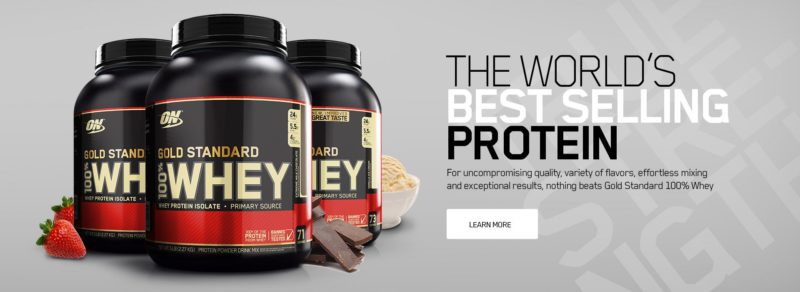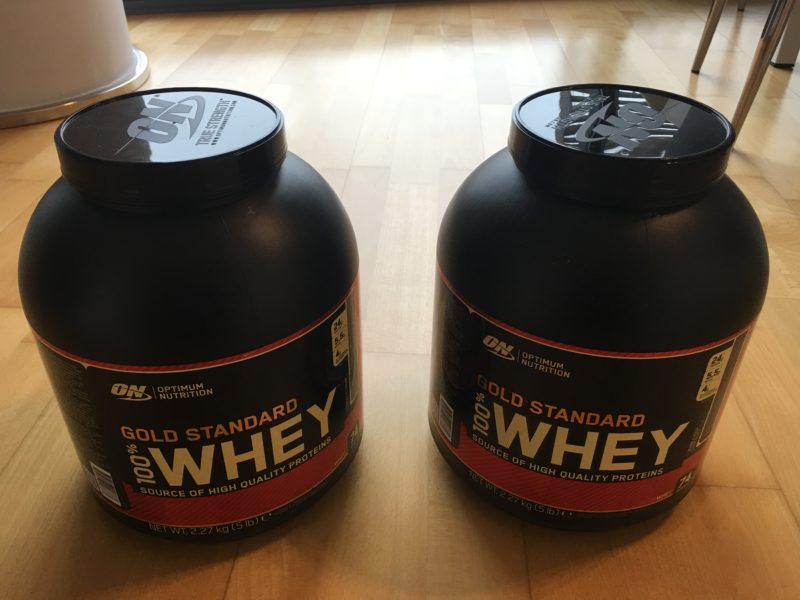
If you’re doing a lot of training or missing certain dietary requirements for some reason or another, you might want to turn to supplements.
When you’re training hard, you need to make sure that you are also taking care of your body’s nutritional needs. You want to make sure that you have enough energy to cover all your expenditure during training and competing, as well as taking in enough protein for muscles to repair themselves and grow if needed to adjust to higher demands.
Below are the products I use. Beware that there are many charlatans that profit off selling and recommending supplements, so do your research very properly, consult with a doctor regularly, and do bloodwork to monitor the effects. I like the content published by doctors Andrew Huberman and Peter Attia, and I also rely on advice from my friend Andrew Farrugia.
Protein Shake

I take a daily protein shake to help cover my protein needs. This can be taken right after your training session or padel match. After such hard exercise, your muscles will have many micro tears that need to be repaired, and protein is what your body needs to be able to do so.
Optimum Nutrition is the number one brand for protein shakes. I’ve tried their Vanilla, Cookies & Cream and Double Chocolate flavors. Double Chocolate is my favorite, and Vanilla is also pretty decent if you want to keep it plain. I wasn’t a big fan of the Cookies & Cream flavor, although it’s bearable. Some flavors work well with milk and water, while others are only tasty if combined with milk. Double Chocolate tastes great either way.
I buy the 2.2kg tub which serves me for around 2.5 months.
Here in Spain, I buy my shakes from one of these two shops, depending on which one of them has the best pricing at that point in time:
Amazon also carries most variations of this protein shake, but the other two shops tend to have better pricing and occasional freebies.
Fruit & Nuts
I know these are not really considered supplements, but it’s important to mention them as they are some of the major sources of fuel during intense activity like long padel matches. Bananas are my favorite food during matches together with dates.
Bananas and dates are excellent sources of fuel during long tennis and padel matches due to their high carbohydrate content, which provides the body with readily available energy. Bananas are rich in potassium, a crucial electrolyte that helps maintain proper muscle function and prevents cramps during intense physical activity. Dates, on the other hand, are packed with natural sugars like glucose and fructose that can be quickly absorbed by the body to replenish energy stores. Additionally, both fruits contain a good amount of fiber, which helps with digestion and promotes a feeling of fullness. Another fruit that works well in this context is the orange, which is high in vitamin C and natural sugars, providing an energy boost and supporting the immune system during strenuous exercise.
Nuts can also be a valuable source of energy during long tennis and padel matches. They are rich in healthy fats, protein, and essential nutrients, such as magnesium and vitamin E, which help maintain energy levels and support overall health. The healthy fats in nuts provide a more sustained energy source, ensuring that you have enough fuel to last throughout the match. Protein, on the other hand, aids in muscle recovery and repair, which is crucial during extended physical activities.
However, it’s essential to consider that nuts are calorie-dense and can take longer to digest than fruits. Eating them in small amounts or combining them with easily digestible carbohydrates, like fruits, can provide a balanced and steady source of energy without causing gastrointestinal discomfort. Some popular options include almonds, cashews, and walnuts, which can be easily carried and consumed during breaks in a match.
BCAAs
I’ve tried BCAAs in the past but the evidence on the benefits of supplementation is scarce, and while BCAAs themselves are important for us, we can get them from food sources and they are also included in some protein shakes. These days I just rely on my diet and protein shake to cover my BCAA needs. Here’s a table showing the BCAA content in various foods that I ingest regularly.
| Food | Serving size | BCAA content |
|---|---|---|
| Ground beef, 90% lean | 3.5 ounces (oz) (100 g) | 4.5 g |
| Chicken breast | 3.5 oz (100 g) | 5.5 g |
| Whey protein powder | 1 scoop (25 g) | 5.9 g |
| Pea protein powder | 1 scoop (25 g) | 4.5 g |
| Canned tuna | 3.5 oz (100 g) | 4.6 g |
| Salmon | 3.5 oz (100 g) | 4 g |
| Ground turkey, 93% lean | 3.5 oz (100 g) | 3.2 g |
| Eggs | 2 eggs | 2.6 g |
| Parmesan cheese | 1 oz (28 g) | 2.2 g |
| Milk, 1% | 8 oz (237 milliliters) | 1.7 g |
| Greek yogurt | 1 cup (227 g) | 4.1 g |
Omega 3
I take a dosage of Omega 3 fish oil daily as its effects have been widely studied and fairly conclusive.
It’s all about maintaining a good omega-3:omega-6-ratio.
I use AAVALABS Omega-3 supplement (2 pills for 1000 mg of premium EPA and 500 mg of DHA).
AAVALABS Omega-3 Fish Oil is a top-tier supplement produced by the Finland-based family-owned company, AAVALABS. The company is well-regarded for its commitment to providing pure, safe, and effective nutritional supplements. AAVALABS maintains strict manufacturing standards, ensuring the omega-3 fish oil is free from contaminants and sourced from wild-caught fish. The company’s dedication to transparency, third-party testing, and sustainability further bolsters its reputation.
Creatine
The positive effects of this supplement have been widely studied as well, so I’ve been using it since I’m doing weight training as well as part of my overall training regimen. It might be the best supplement to use in fact, since it has proven effects and little to no downsides. I use MyProtein’s Creatine Monohydrate pack. If you want something better you can get Creapure. Creapure® is the brand name for pure creatine monohydrate produced by AlzChem Trostberg GmbH in Germany. MyProtein sells both Creapure and Creatine Monohydrate, and Creapure costs around 3x as much.
When you workout and exercise, whether this be weight training or cardiovascular activity, your body requires energy to perform muscle contractions. Muscle contractions move your body parts. For example, when you perform a bicep curl you will contract your bicep muscle, and to do this requires energy.
Adenosine triphosphate (ATP) is the chemical compound your body uses for energy. For a muscle to contract, it will break off a phosphate molecule from ATP, meaning ATP becomes ADP (adenosine diphosphate). To form more ATP your body will take a phosphate molecule from your body’s stores of creatine phosphate.
So as you have probably worked out, creatine is vitally important for muscle contraction. Therefore, supplementing with creatine can help your body to perform more muscle contractions, meaning more reps, and more reps can breakdown more muscle fibers. With the right nutrition and recovery, this can increase your potential for muscle growth.
According to studies, there are no negative effects of long-term supplementation with Creatine.
Our bodies produce creatine endogenously at around 1g per day. You can also obtain small amounts of creatine through food, especially red meat. At a max you’re looking at 1g per day in food, so at best you have a total 2g of creatine in your body per day without supplementation.
Supplementation increases muscle creatine content by around 20%. The biggest effects of creatine are seen in anaerobic short duration sports activity (less than 30 seconds) so you’ll see a difference while lifting weights, for example.
I target 3g per day usually at some point after training. You could also have a loading phase of 20-25g per day for 3-5 days following which you’d switch back to 3-5g per day. If you don’t load, you will start seeing the effects of creatine in a few weeks versus a few days with the loading phase.
Note that in around 20-30% of the population supplementation has no effects due to them having already high levels of creatine in their muscles and less type 2 fibers.
Here’s a good article if you want to read about creatine in further depth (in Spanish).
Some people recommend using 0.1 grams per kg of bodyweight, but it is not proven to be more effective than a more moderate amount. According to scientists at St. Francis Xavier University in Nova Scotia, at 0.1 grams per kilogram of bodyweight, male athletes excreted 46% of the ingested creatine within 24 hours. For a 220 pound lifter, this means that if he consumes 10g of creatine, 46%, or 4.6g of creatine, is wasted. In another study performed at the Human Performance Laboratory at Ball State University, scientists confirmed that lower doses of creatine monohydrate (5g/day) are effective, and that results can even be achieved without a loading phase.
I therefore stick to 5g daily.
Caffeine
Probably the most commonly used supplement. Everyone knows the effects of caffeine as a stimulant. It helps you be more active and alert, but on the downside, it can also make you edgy.
I typically take 2-3 espressos throughout the day, and it doesn’t affect my sleep negatively. In fact I sometimes use it for power naps in the afternoon (take an espresso then sleep for 15-30 minutes).
I’ve also taken to making cold press coffee with an Aeropress, which is handy as there is always coffee ready for me in the fridge, and it also reduces my daily intake of coffee, from around 54g for 3 espressos to 38g for the cold press (500ml).
Vitamins
I’ve experimented with vitamins over the years but have never found any obvious results due to their intake. The scientific opinion these days seems to be that unless you have major nutritional deficits you should be able to obtain all the vitamins you need from your food and some daily exposure to sun (Vitamin D).
If you live in countries that are not blessed by daily sunshine, you might need to supplement Vitamin D. Check out this free full-text paper on vitamin D in health and disease.
Moreover, vitamin D may boost strength and athletic performance. 2000 IU/day is a conservative and safe dosage, but some go higher without negative implications. (>5000 IU).
On the other hand, we need to be very careful with sun exposure. In countries with outdoor courts, padel players can end up accumulating many hours in the sun and that’s proven to not be a healthy thing.
Skin cancer is a real thing and we need to protect our skin against it. I use an SPF 30 sunscreen by ISDIN (a good brand here in Spain) and apply it 30 minutes before I play. Typically one application will last for 2 hours, which conveniently is just about the time that a match lasts on average. If you sweat a lot like me it is also a good idea to reapply sunscreen in between sets to make sure that you are still protected. Make sure to apply cream over all exposed areas of the body including often forgotten areas like the back of the neck and the tops of the ears. Bald guys need to be especially careful with their heads when playing in the sun, and here the best option is to use a hat and possibly even glasses to protect the eyes from harmful UV.
Remember that while some sunshine is healthy, we are talking about only around 15 minutes of sun exposure to get all the vitamin D needed for the day. So a full match in the sun is definitely too much exposure unless adequate protection is used. The sunscreen I use is specially formulated to be water and sweat resistant and designed for use in sports. One final option is to cover yourself using long sleeved t shirts and longer shorts, although I’m not a big fan of that and prefer to use sunscreen.
I do regular bloodwork to make sure that all my vitamin levels are good. A good doctor will easily identify any issues there and suggest which supplements to take, if any.
Supplements like vitamin B12, iron, magnesium, zinc, folate etc can easily be tested and there is no real need in supplementing if your levels are adequate (worth extra vigilance if following a restrictive diet e.g. veganism).
As a general rule, using a multivitamin is not a good idea.
While multivitamins may appear to be an easy panacea, their execution tends to be poor. Focusing too heavily on the “multi” aspect, most tend to have below-optimal dosages of vitamins, tending to focus more on having a plethora of vitamins/minerals present. Some vitamins are simply not really needed at all (vitamin C for example). It is likely more prudent to get a few specific vitamins and minerals in isolation.
An easy method to cover yourself is to eat LOTS of vegetables with each meal or snack. Order an extra side salad when you eat out, make extra vegetables when you cook and have vegetables (and fruit) easily available to snack on.
It’s also important to customize your supplementation plan according to your needs. One thing I’ve done is to download the raw data from my 23andme profile, then run it through Rhonda Patrick’s Genetic Reports system to get a custom report on what things I need to look out for due to my DNA markers. For example, I discovered that taking a fish oil supplement is particularly beneficial to people with a particular gene that I have.
What supplements have worked for you? I’m curious to know, just leave a comment below.
If you want to learn more about supplementation, the best resource I’ve found is Examine.com and you can also check the analysis done on Labdoor and Consumerlab.
You should also get regular bloodwork done and discuss the results with your nutritionist for further fine-tuning. I find this website really good for digging deeper into specific bloodwork results and helping you understand such results.

Great article. I like Omega 3’s and vitamins. Vitamin D3 is the most important vitamin for me. But I always go with things that are natural. I don’t like medications. I love vegetables too. What do you feel are the most important things for your health? I would like to know. I shall return. Stay safe.